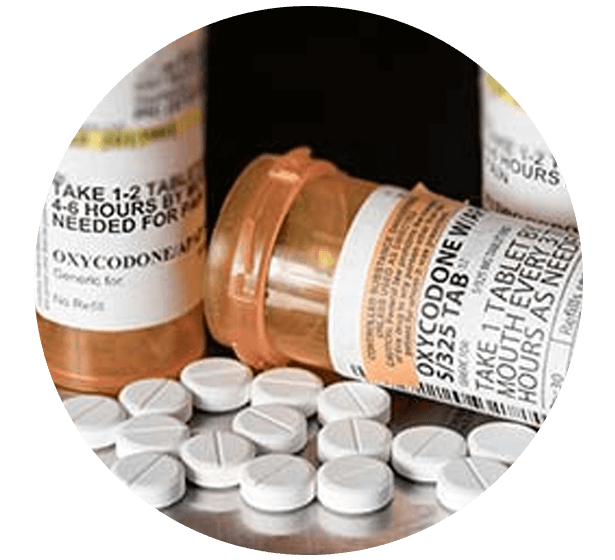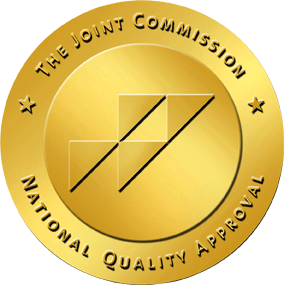Oxycodone Addiction Treatment
Oxycodone abuse often begins with a legitimate prescription for moderate to severe pain management, but the risk of addiction is high. Oxycodone is one of the most misused prescription opioid pain relievers. It was originally intended to treat severe pain, but it’s become synonymous with the opioid crisis plaguing the United States right now.
Also known by the brand names Oxycontin and Percocet, oxycodone belongs to the opiate family of drugs. Prescription opioid misuse and addiction is a risk that comes with all drugs in this category. Rising prescription pain medication misuse has led to federal and state programs aimed at addressing opioid abuse as a deadly epidemic. The National Institute on Drug Abuse reports that opioids were involved in over 50,000 U.S. overdose deaths in 2019.
What Is Oxycodone?

Oxycodone comes from opium of the poppy plant and is partially human made. It’s a semi-synthetic opioid. Formulations of oxycodone containing acetaminophen, aspirin, or only oxycodone are all listed as Schedule II drugs by the Drug Enforcement Agency (DEA). This means it has a high potential for abuse and physical and psychological dependence. Oxycodone abuse dates back to the 1960s, and it’s well-known for euphoria-producing effects. Even though the country was not in the grips of the current opioid epidemic, heroin was a major concern during the 1960s and 1970s. During this time, scores of injured and under-insured Vietnam veterans were returning home with heroin dealers waiting to distribute. It wouldn’t be until the mid-1990s with the release and marketing of an extended-release version of oxycodone (OxyContin®), that the greatest opioid epidemic of our time would begin. Despite claims by the manufacturer that it had a low potential for abuse, extended-release oxycodone could be easily crushed, releasing the full 12-hours’ worth of oxycodone at once. With prescribing practices by some doctors who believed the marketing claims that it was not abusable, oxycodone flooded the pharmacies. It played an integral role in kicking off the opioid epidemic we now face. Many heroin users today started with opioid medications like OxyContin. By seeking oxycodone addiction treatment early your risk of transitioning to drugs like heroin is reduced.
Effects of Oxycodone
Oxycodone Side Effects
Oxycodone may cause similar effects as other opioid painkillers. Those can range from mild to serious side effects, like:- Euphoria
- Drowsiness
- Confusion
- Slowed breathing or trouble breathing
- Flushing
- Low blood pressure
- Slurred speech
- Dizziness
- Nausea / vomiting
- Constipation
- Dry mouth
- Seizures
- Heavy limbs
- Constricted pupils
Oxycodone Withdrawal Symptoms
Once you’re addicted to oxycodone, your body will experience withdrawal symptoms when you stop using it. Oxycodone withdrawal symptoms include several painful and uncomfortable symptoms that range from mild to severe. Your physical health and the severity of oxycodone abuse are strong factors in the length of time it takes to complete detox. Typically, a medically assisted detox from oxycodone can last between five and 14 days with symptoms significantly easing around the third or fourth day. Although oxycodone detox usually doesn’t come with life-threatening withdrawal symptoms, it can feel excruciating if you have an opioid addiction. You can experience a combination of physical and psychological symptoms such as:- Runny nose
- Increased anxiety
- Watery eyes
- High fever
- Restlessness
- Muscle aches and spasms
- High blood pressure
- Abdominal pain
- Nausea and vomiting
- Diarrhea
- Rapid heart rate
- Intense cravings
- Sweating
- Chills
- Clammy skin
- Excessive yawning
- Insomnia
- Agitation
- Joint pain
- Depression
Oxycodone Overdose Symptoms
Excessive oxycodone abuse can cause an opioid overdose, which can be fatal. Naloxone is a safe medication that can be administered by emergency medical workers, trained professionals, and laypeople (in some states) to stop an overdose from becoming fatal. Early intervention is critical. Opioid overdose symptoms include:- Small, constricted “pinpoint pupils”
- Falling asleep or loss of consciousness
- Slow breathing
- Choking or gurgling sounds
- Limp body
- Pale, blue, or cold skin
Signs You’re Addicted to Oxycodone
Oxycodone addiction can develop faster than you think, especially when you’re taking the drug in dangerous ways, like snorting it or injecting it intravenously.
The American Society of Addiction Medicine (ASAM) defines addiction as a primary, chronic disease of:
- Brain reward
- Motivation
- Memory
- Related circuitry
Addiction is uniquely characterized by the behaviors associated with it. These are destructive and include drug-seeking behaviors like:
- Doctor shopping
- Stealing money or oxycodone from loved ones
- Ruminating about using oxycodone and other drugs
- Continued use of oxycodone despite negative consequences
- Taking risks like drinking alcohol or using other drugs with oxycodone to enhance your high
The consequences of oxycodone addiction rarely end until you seek help — and that does not necessarily need to be at rock bottom. Addiction can make life unmanageable for you and your loved ones. Difficulties resulting from substance abuse include:
- Legal troubles from stealing or buying oxycodone illegally
- Health complications
- Financial problems
- Strained relationships with loved ones
- Loss or reduction in earning capability
- Serious accidental injury to yourself or others while taking oxycodone
Over time, taking opioids can change your brain’s structure, removing special connections between neurons. This can force your brain to rely on opioid compounds for functions like thought, emotion, and critical thinking.
Opioid abuse and addiction revise your brain’s reward system, fueling irresistible cravings for oxycodone. The smallest triggers can jumpstart the need for more oxycodone. The biggest triggers make the desire for opioids unbearable.
The final piece of the puzzle that makes oxycodone so addictive is that after long-term exposure, your brain cannot function without it. When you stop taking oxycodone, you may experience withdrawal symptoms that make you even more dependent on the medication just to feel normal.
Some common signs and symptoms of an opioid addiction include:
- The inability to control use
- Uncontrollable cravings
- Drowsiness
- Changes in sleep habits
- Weight loss
- Frequent flu-like symptoms
- Decreased sex drive
- Lack of hygiene
- Changes in exercise habits
- Isolation from family or friends
- Stealing from family, friends, or businesses
- New financial difficulties
- Inability to abstain from oxycodone abuse
- Behavioral control issues
- Intense cravings to use oxycodone
- Inability to recognize problems and dangers associated with addictive behaviors
- Impaired and dysfunctional emotional responses
- Chronic withdrawal
- Mental health symptoms like depression or anxiety
How Do You Treat Opioid Addiction?
Addiction is a disease. That means it’s not a matter of choice or willpower. It can fundamentally change your brain chemistry, which is why quitting can feel so challenging.
Early recovery often involves five steps:
- Intervention
- Medical detox
- Opioid withdrawal management
- Long-term treatment and therapies
- Aftercare
Intervention
If your loved one is addicted to opioids and refuses to get help, it may be necessary to stage an intervention. This is a properly planned and carried out group meeting between your loved one, their close friends and family, and a trained moderator or professional interventionist. The goal is to convince your loved one that they have a problem with substance abuse and need to enroll in a treatment program immediately.
When successful, the individual accepts the need for help with their oxycodone problem. They then begin working with the interventionist and their friends and family on how to connect with a treatment center.
Interventions can be very emotional and contentious experiences. They are best held in the presence and supervision of a trained interventionist.
Medical Detox
The first step of oxycodone treatment at a facility is medically supervised detox. This is where you’ll go through a slow process of decreasing your physical need for opioids. When you stop taking oxycodone, your body will start to detox naturally, which will likely result in opioid withdrawal symptoms. These can be uncomfortable, even dangerous, and the risk of relapse is high. That’s why detoxing under medical supervision is crucial. You can be monitored and supported by medical professionals.
During detox from oxycodone, you may also require medication-assisted treatment (MAT) with medication for opioid abuse like buprenorphine. In a clinical setting, MAT will be administered by health care providers.
Treatment
Once detox is complete, the next step of recovery is a structured treatment program. There are several different levels of treatment which vary depending on the level of care you require. Levels of treatment include the following:
Residential Treatment
Inpatient treatment consists of 24/7 monitoring, supervision, and ongoing care. You may benefit from inpatient rehab if you struggle with chronic relapse. Inpatient oxycodone treatment is usually ideal for severe addiction. The length of a residential stay ranges from about 28 to 90 days.
Partial Hospitalization Program (PHP)
PHP includes extensive structure and support for clients who don’t need full 24/7 monitoring. You may transition into this level of care after completing inpatient treatment, or you can enter oxycodone treatment at this level. You’ll receive clinical services at a treatment facility throughout the day, but you won’t live there. Many people choose to live in a sober living residence while in partial hospitalization.
Intensive Outpatient Program (IOP)
Less structured than PHP, an IOP for oxycodone is often recommended after you complete inpatient or partial hospitalization programming. Many people work or attend school while in IOP. You’ll learn how to integrate your recovery into the real world.
Outpatient Treatment
Outpatient rehab is best if you suffer from a mild oxycodone addiction or you’ve already progressed through PHP or IOP. It also usually refers to long-term aftercare. Many clients remain in outpatient treatment for several weeks or months for ongoing support. All treatment options typically include a combination of group and individual therapies. These therapies support you, teaching you the skills you need to pursue a life without oxycodone and offering insight into these areas:
- Trauma
- Relapse prevention
- Self-esteem and self-worth
- Family dynamics
- Life skills (employment, legal issues, housing, etc.)
- Peer support
- Creative expression (writing, music, art)
- Cognitive behavioral therapy (CBT)
Aftercare
Recovery doesn’t end when treatment ends. Aftercare, like 12-step groups and alumni programs, are important in preventing opioid abuse relapse. You need to practice coping skills and engaging in a positive support system to ensure a drug-free life. Aftercare can be lifelong, always providing you with a core group of advocates and friends who will be there in times of struggle and loneliness. This offering of strength and solidarity can go a long way in helping you enjoy a full and rich life in recovery.
How Long Will I Be in Treatment for an Oxycodone Addiction?

Everyone is different, so their treatment timeline is different too. Things that impact treatment time include:
- The length of time you used oxycodone.
- The amount of oxycodone you took each time.
- How frequently you used.
- If you require medication treatment to detox.
- The presence of underlying medical or mental illness issues.
Oxycodone Treatment at Vogue Recovery Center
- Identifying the people, places, and things that are personal triggers for relapse.
- Addressing underlying issues, traumas, and problems, which may have contributed to initial drug abuse.
- Understanding abilities and limits in recovery to maintain abstinence from further drug abuse.
- Customizing a detailed aftercare plan, including where to live and work, how to engage in sober activities, and connecting with individual and group support.
Does Insurance Cover Oxycodone Treatment?
Most insurance plans cover behavioral health treatment like they do other medical conditions. Specific benefits usually vary by level of care and length of treatment. Vogue accepts most health insurance plans. If you have insurance questions, call us. We will work with your insurance provider to determine your benefits.
Get Help
Recovery from oxycodone is possible. At Vogue Recovery Center, we’re ready to support you or your loved one. We’re passionate about recovery. We know addiction treatment saves lives. And we’re here for you from detox, throughout treatment, and after you leave us to support you in your recovery. Call us today to take the next step in building your new life.
References
- https://www.drugabuse.gov/drug-topics/opioids/opioid-overdose-crisis
- https://www.deadiversion.usdoj.gov/schedules/
- https://pubmed.ncbi.nlm.nih.gov/24287106/
- https://www.cdc.gov/drugoverdose/training/oud/accessible/index.html
- https://www.hopkinsmedicine.org/opioids/signs-of-opioid-abuse.html
- https://www.asam.org/quality-care/definition-of-addiction
- https://www.asam.org/docs/default-source/education-docs/opioid-names_generic-brand-street_it-matttrs_8-28-17.pdf?sfvrsn=7b0640c2_2

Medically Reviewed by Jessica Elbe, LCSW



